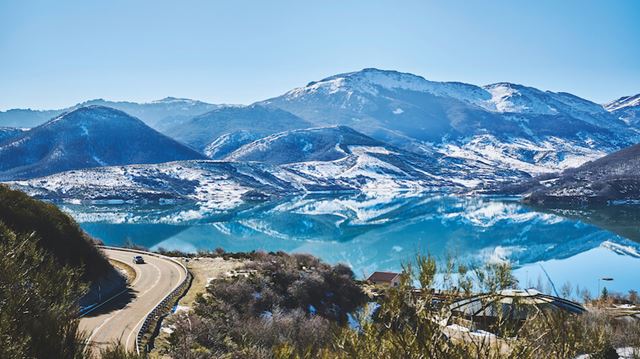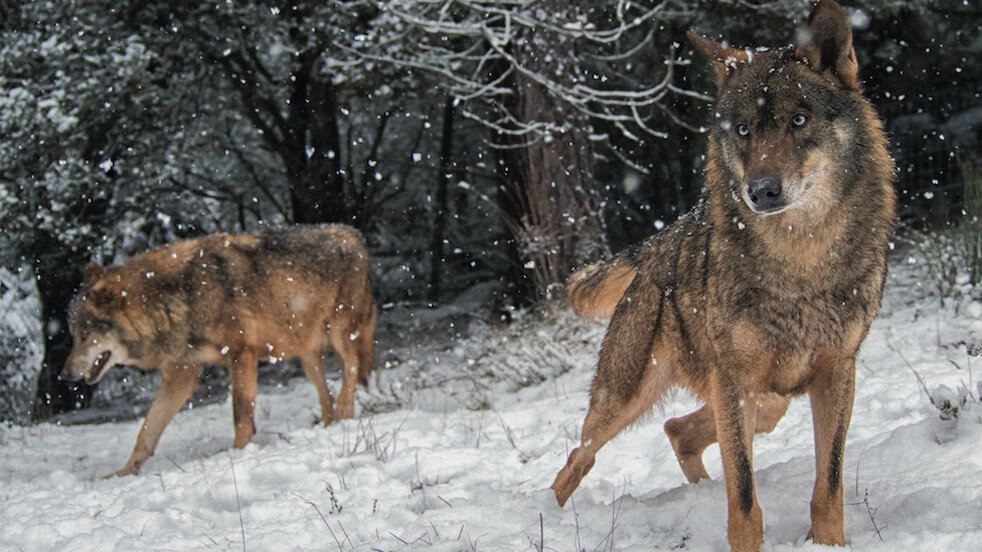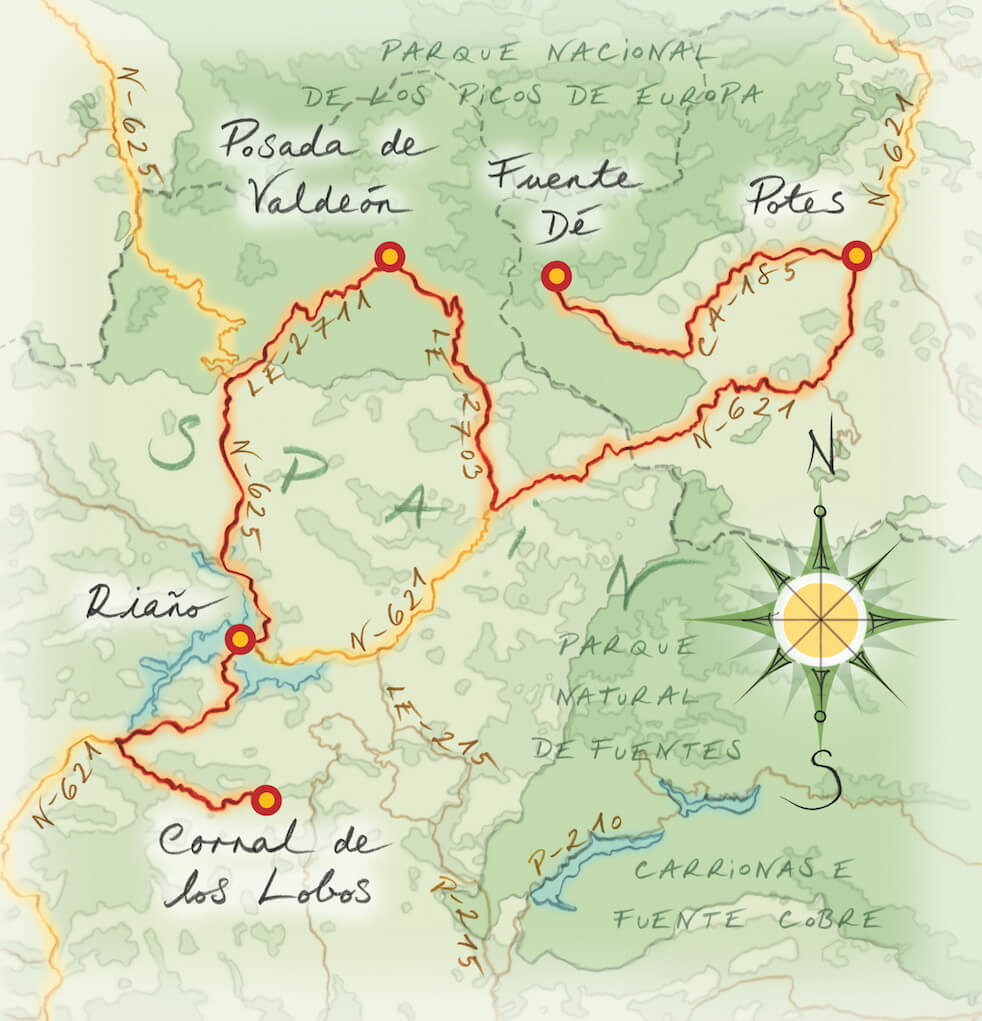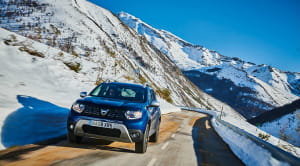
Discover northern Spain’s mountainous and wildlife-packed national park on a one-of-a-kind road trip around Riaño
The Iberian Peninsula in the Cantabrian mountain range is home to 2,500 European wolves. Tracking them down makes for an epic drive.
Standing among movie-set mountains, with vultures circling overhead and huge paw prints in the snow around us, it’s hard to believe that just a few hours ago we were chugging across the Bay of Biscay as the sun came up. We were delivered on the overnight ferry from Portsmouth to Bilbao, a journey of just 500 or so nautical miles from the UK across an occasionally choppy stretch of sea. Yet it’s as if we’ve been transported way across the Atlantic to the Canadian Rockies or some other far-flung wilderness.
It’s those paw prints we’ve come for. Because here in the Picos de Europa in the far north of Spain, you’ll find some of the most extraordinary – and perhaps surprising – wildlife in the whole of Europe. Aside from those vultures, the list of local creatures includes golden eagles, black kites, Cantabrian brown bears, wild boar and wildcats. The big attraction, though, is the wolf, and that’s what we’re hoping to see. The Iberian Peninsula is home to more than 2500 of them and the Picos are one of their strongholds.
Separating Spain’s arid heartland from its wild north coast, the iced limestone hulks of the Picos – part of the wider Cantabrian range – could easily be mistaken for their north American counterparts. These, thankfully, are much easier to get to. You could drive down through France, or fly to Bilbao, just a two-hour flight from London. We’ve braved the 24-hour sea crossing across the Bay of Biscay with a bijou (OK, budget) four-berth cabin plus a space on the car deck for our car.
Read more about our road test of the Dacia Duster in Spain
Wolf-watching in Spain
We base ourselves just south of the National Park in Riaño. It was built when old Riaño, along with several other villages, was submerged – somewhat scandalously – in the 1980s, to create the reservoir that now reflects the surrounding peaks and high pastures full of grazing sheep, cattle and horses. Among these live 14 local wolf packs, making this a terrifying place to be a woolly thing, and also one of the best areas in Europe to see wolves in the wild.
Having said that, you’ll need more than a tin of Pedigree Chum to track them down. So we’ve enlisted the help of two guides, Iñaki Reyero and Jorge Escanciano from WildWatching Spain, which runs trips for tourists hoping to glimpse the region’s fauna. What are the odds of a wolf sighting today? “Now’s not a good time of year,” says Iñaki, eyeing the late winter snowfall. “They are mating and moving around because food is scarce. And the territory of one pack is very large – 100 square kilometres. In summer they stay close to their dens, so the chances are more like 90%, but we’ll try…”
In the passenger seat, Jorge scans the slopes. As we pass through one of the rocky gorges that cleave the peaks, he spots something. Winter might be the hardest time to see wolves, but there’s one major advantage to the snow: you can tell what’s just walked across it. In this case it’s a lone wolf, its paw prints pressed lightly into the surface in a dead-straight line – unlike excitable domestic dogs, wolves tend to move with ruthless efficiency. We get out and follow the tracks across a wooden footbridge, over a gurgling clear stream (obviously this wolf didn’t fancy a dip) and into the pines.

New Riaño, built on a hill to replace the old town that was flooded to create the reservoir. The submerged buildings now lie directly under the bridge.
Wildlife in Spain: wolves, bears and vultures
Suddenly Jorge stops and points to some much bigger, almost cartoonish paw prints. “A bear,” he says with a little smile, while the rest of us consider the best escape route. The biggest Cantabrian brown bears can weigh up to 200kg – they’re basically Spanish grizzlies – and at the last count there were some 230 here. Soon, though, we’re distracted from bears by a commotion further up the mountainside, as a mob of crooked vultures descend on the remains of a red deer – likely the victim of a recent wolf attack. “Let’s come back tonight,” decides Jorge. “They might return to finish their dinner.”
Although very closely related to the grey wolf, the Iberian wolf is browner and smaller – closer in size and appearance to a German shepherd. Historically the population was huge, though through the 19th century they were hunted almost to extinction – later we visit an old trap where the animals were flushed out of the forest into a V-shaped enclosure with a deep well at the tip, into which they would fall and could be easily killed. Today they have government protection and their numbers have recovered from their 1970s low. But does the wolf deserve its big, bad reputation?
“Reading stories as a child, I thought they were monsters,” says Iñaki. “But when I was 11 years old, I met two cubs in a valley near home, and my mind changed completely – they’re incredible, peaceful animals.” Jorge agrees. “When you’re alone in the forest and they’re howling, it’s really beautiful,” he says. “Yes, if they get to unprotected sheep they can destroy them all, but remember, we’re breeding our livestock in their territory.”
But what do the farmers think? For some, the age-old war won’t be complete until the enemy is completely eradicated, despite the fact that they receive compensation for any animals lost to wolves. Others are more sympathetic. In the tiny village of Espejos de la Reina, where old oak beams sigh under terracotta-tiled roofs, and our Dacia Duster squeezes through the narrow main street, we meet Julio del Cojo whose family has farmed here for generations. What’s it like to live among los lobos, we ask?
“I’ve never had any problem with wolves,” he says. “If you are a good herder, you won’t have any trouble. If you forget about your sheep that’s when you have a problem because the wolf has to hunt. If there is no protection around he will hunt.”
As he talks, a fluffy Spanish mastiff puppy tugs at his blue overalls. Soon it will grow into an enormous, lolloping beast and live full-time with a herd of sheep, goats or cows, going where they go and patrolling their patch like a jowly bouncer. While they’re soppy with humans and generally lazy – at one point we find one lying right in the middle of the road, oblivious to traffic – these gentle giants have been defending livestock for centuries and are able to fend off several wolves at a time.

2500 wolves roam the Iberian Peninsula. They're easiest to see in August and September.
The local wildlife guides
Back in the car, we return to the site of the deer kill, climb up the opposite side of the valley and look back with binoculars, long lenses and telescopes. After an hour of silent observation, and just as we’re losing hope, something appears in the murky half-light far across the valley – an unmistakably canine shadow, with ears pricked and alert. It’s too dark and distant for the cameras to capture, but there it is, if only for a moment or two – a wild wolf, the stuff of folklore, fairy tale and fable, seen with our very own eyes.
“August and September are the best months for wolf watching, and for bears too,” says Iñaki. If you’re lucky you’ll tick off even more, including the elusive capercaillie – a flamboyant black grouse – as well as Iberian ibex, red deer and chamois, the half-goat half-antelope whose soft hides we shine our cars with.
More great road trips in the UK and Europe
A great drive around Sicily: reliving the Targo Florio
A road trip through Northumberland: around Kielder observatory and Hadrian's Wall
Drive the mountains, valleys and Roman roads of the Lake District National Park
Plan your Picos de Europa trip: how to get there

You can fly directly to Bilbao from several UK airports, and on budget airlines. Brittany Ferries has crossings to Bilbao and Santander from Plymouth and Portsmouth, taking 24 – 28 hours and costing from £235 each way, based on two people, including a car and cabin.
Where to stay in the Picos de Europa
We stayed at the Hotel Tierra de la Reina in Boca de Huérgano, a favourite with wildlife watchers. Prices range from £26 per night in low season to £52 in summer. The rooms are spotless and modern, and the menu – as with most places in the Picos – is dominated by meats, game stews and cheeses.
Wildlife watching: when and where to go
Summer and late summer, particularly in August and September, is the best time to see wolves, wildcats and bears. Riaño is the heart of wolf-watching country; for bears it’s better to head slightly west to Somiedo. The Picos National Park and surrounding ranges are also home to all sorts of birdlife, from raptors to woodpeckers.
Wildlife watching: local guides
WildWatching Spain runs tours covering all the best spots, run by experienced local guides. Packages include accommodation, transfers and meals, plus observation equipment. A seven-day trip costs around £850 per person. All tours are based on a scrupulous respect for the animals and their environment.
Walking in the Picos de Europa
The Picos de Europa has some of the most breathtaking walking routes in Spain, including the Cares Trail. Originally built as a maintenance track for hydro-electric workers, it follows the Cares river through an improbably deep gorge with several dramatic tunnels. The hike from Poncebos in the north of the Park, to Caín de Valdeón in the middle, takes around three hours each way (or you could continue over the other side, towards Riaño). The Picos is a great destination for cross-country skiing and snowshoeing during winter, too.




